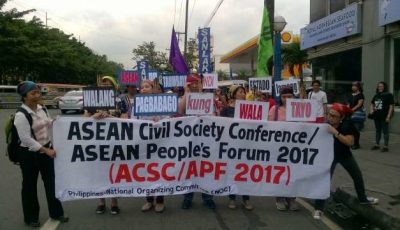Deepening Solidarities Beyond Borders Among Southeast Asian Peoples
A Vision for a Peoples’ Alternative Regional Integration

Introduction
The perceived failure of the Association of Southeast Asian Nations (ASEAN) to meaningfully address the issues and concerns of Southeast Asian peoples is viewed by the Asean Civil Society Conference/Asean Peoples’ Forum (ACSC/APF) as rooted in the ASEAN’s being locked in a market-centered and state-supported process conceived by regional and national elites to perpetuate their control over the region’s natural resources and productive capacities.
Under the mantra of “profits before people,” ASEAN leaders make decisions without the meaningful participation of the marginalized and disenfranchised peoples of the region and are accountable only to the narrow vested interests of economic elites and political oligarchies. This has only further widened the gap between rich and poor within and among countries, and caused unparalleled debasement of the environment. ACSC/APF notes that ASEAN’s continued adherence to a neoliberal model of development prioritizes corporate interests and elite groups over the interests of Southeast Asian peoples.
Given the above, this vision paper proposes charting new directions and crafting new modes of regional integration for Southeast Asian peoples in light of an in-house assessment by ACSC/APF that ten years of engagement with the official ASEAN process from 2005 to 2015 have been consistently characterized by “ambivalence, hesitation, resistance” by ASEAN governments leading to “disappointment and frustration…on the part of civil society” (Lopa 2016, 58). This paper recommends a radical restructuring of civil society engagements with Southeast Asian states by crafting a new regional peoples’ integration in order to implement an agenda independent of the state and the corporate-biased ASEAN process.
Premises
Several premises underpin the need for new directions and strategies for Southeast Asian civil society groups and movements. The first is to make a distinction between Southeast Asia as a geographic region and its peoples and diverse cultures and histories on the one hand, and ASEAN as a regional organization locked in a market-centered and state-supported process with a particular ideology and strategy of development on the other. This strategy was conceived and undertaken by regional and national elites to perpetuate their control over the region’s natural resources and productive capacities and rule over the greater masses of Southeast Asian peoples. Starting in 1967 as a mechanism to support the United States (US)-led Western faction of the Cold War, it has evolved into a tool of the neoliberal market-led agenda of development promoted by global capitalism.
Southeast Asia is a much greater entity than what ASEAN currently encompasses. Various scholars have argued that the region should not be confined to the ten ASEAN member states, but should include areas in other countries whose peoples bear similar cultural and ethnic characteristics as those who live in what has been normally referred to as Southeast Asia. In addition to Papua New Guinea and Timor Leste, both of which continue to be denied full ASEAN membership, references have been made of Southeast Asian historical affinities with parts of Northeast India and three southwestern provinces of China (Scott 2009, 13–14).3 Our vision of a region without borders is, therefore, not contingent on citizenship and location.
Secondly, the crucial decisions accompanying initiatives and developments in the ASEAN process have been made without the participation of the marginalized and disenfranchised peoples in the region. Thus, ASEAN’s leaders and the decisions they make are not accountable to the people, only to the narrow vested interests that their corporate allies and political oligarchies represent.
Thirdly, ASEAN’s guiding framework of “profits before people” and unbridled economic growth, which is encouraged and supported by international financial institutions (IFIs), has only further widened the gap between rich and poor within and among countries, and caused unparalleled debasement of the environment. As the ACSC/APF 2015 statement argued,
The failure of ASEAN to meaningfully address the people’s issues is deeply rooted in the organisation’s continued adherence to a neo-liberal model that prioritizes corporate interests and elite groups, including state-owned enterprises, over the interests of the people. (ACSC/APF 2015, 1)
Fourthly, ASEAN’s unbending adherence to the 17th century Westphalian state model which emphasizes absolute sovereignty and unrestricted territorial integrity has been a convenient shield by member governments and elites against being held accountable for actions that oppress peoples and debase nature. Moreover, as scholar-activist Kinhide Mushakoji has written, this model may no longer be that relevant in the age of 21st-century globalization, where porous boundaries and labor migration patterns have created dual and sometimes multiple identities of peoples transcending ethnic and cultural lines (Mushakoji 2014, 133–37). Mushakoji’s notion of “multi-ethnic, multi-identity, and multi-cultural societies” effectively clouds the concept of a distinct and singular national identity.
Southeast Asian civil society must, therefore, look and reach beyond the narrow boundaries of nation-states, territorial demarcations, and ethnic distinctions in order to develop a regional solidarity and identity based on common histories, aspirations, and a vision that would transcend the narrow confines of territories, nationalities, ethnic identities, and citizenships. The ACSC/APF, in its vision, goals, and objectives, should operate accordingly.
The above perspective is especially relevant in light of territorial disputes that characterize the region and the relationships among its nation-states. If identities are shared regionally and the notion of homogenous racial stereotypes are rejected, this would go a long way in easing tensions among nations and facilitating the peaceful resolution of disputes.
Click here to read the entire discussion.
*
Note to readers: Please click the share buttons above or below. Forward this article to your email lists. Crosspost on your blog site, internet forums, etc.
Featured image is from Focus on the Global South

